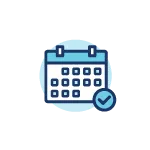The New Year is officially here and money is on a lot of people’s minds. According to a recent study, 44% of New Year’s resolutions are to start saving more.
What is the best way to save money and how do you even get started?
Before you begin to save money this year, you first need to create a money plan for the New Year. And yes, you guessed it — that plan is called a budget.
Create a Starting Point
Before you decide where you want to go, you first need to examine your current financial situation.
The best way to do this is to go back over the past year and look over all your bank statements. If you only bank at one financial institution, then this is going to be simple — just print off your bank statements for the past year.
Nonetheless, if you’re like most people, you probably have multiple accounts, including checking, savings, and credit card accounts, and they’re all at different financial institutions. If this is the case, then it may feel like you’re about to sacrifice an entire forest to print off all your bank statements!
However, if you are currently a member at OneAZ Credit Union, you can take advantage of Next Level Banking which allows you to pull all banking transactions from all outside financial institutions into one easy-to-see online dashboard.
Dumping the Gray Charges
The good news is you are also about to give yourself a raise!
After you start going through your expenses, you may start to notice small fees or charges that have been occurring over the past year. These are known as gray charges.
Gray charges are those small charges that maybe you forgot about or didn’t notice. These include subscription fees, recurring membership fees and one-time renewal charges that are often overlooked.
Although they may only be a few bucks per month, over time they really start to add up. It’s time to give yourself a little raise each month by finding and then getting rid of all the gray charges.
Keep an eye out for errors with any of your expenses. It’s common to have been billed twice in the same month or to see an irregular spike in a bill you expect to be the same each month. Although it may feel tedious, keep in mind you could find hundreds of dollars in savings by digging through your statements.
Identify Budget Categories
Now that you have all your transactions in front of you, it’s time to create categories to make budgeting easier.
Group your spending into common themes like “Gas” and “Groceries.”
Here are some ideas to jump start your budget categories:
- Groceries
- Gas
- Dining Out
- Entertainment
- Shopping
- Health and Beauty
- Mortgage/Rent
- Insurance
- Utilities
- Cell Phone
- Subscriptions
- Savings
Now that you have all your transactions and newly created categories in front of you, it’s time to take a slow deep breath.
I know what you’re probably thinking — we spent that much money last year?!
If this is you, please don’t worry. Just about everyone who creates a budget for the New Year will feel the exact same way you are feeling right now.
Determine Your Income
Now I know knowing your income seems obvious, but then again it may not be as obvious as you think.
There is a difference between your income and what you take home each month. Therefore, when determining your income, you need to find out how much actually hits your checking account each month.
Believe it or not, how you get paid will have a huge impact on how you set up your New Year’s budget.
For example, if you get paid every two weeks, then determining your income each month is very straightforward. But what if you get paid on commission and you can’t rely on bi-weekly paychecks?
When this happens, you need to determine your monthly income based on your last 90 days.
Example:
October Income: $4,000
November Income: $5,000
December Income: $0
As you can see, you received an income the first two months but then nothing during that last month. However, looking back over the past 90 days, you determine your average monthly income is $3,000.
Therefore, when creating your New Year’s budget on a fluctuating income, it’s best to continually use the average monthly income for your last three months.
Organize Your Expenses
Up to this point you have cut out the gray charges and combed through the past year’s expenses to create categories based on your spending habits.
Then, you determined your income so you can figure out how much you have to spend each month inside your new budget.
It’s time to simplify your budget by identifying recurring expenses that stay the same each month.
Your recurring expenses may include:
- Mortgage/Rent
- Car Payment
- Insurance Premiums
- Cable Bill
- Internet Bill
- Cell Phone Bill
- Gym Memberships
- Recurring Services
- Health Insurance
- Home Services
All Other Expenses
Whenever someone is worried about creating a budget, it’s the irregular expenses they’re stressing about.
Those “other expenses” are the things that can go up and down each month and are also the things that can quickly get out of control in terms of spending.
Remember earlier when you thought to yourself:
“We spent this much money going out to eat last year?”
Or maybe you said to yourself:
“We sent that much money to Amazon last year?”
Take all your categories from earlier and average out what you spent each month. For example, if you spent a total of $8,000 at the grocery store last year, then your monthly average for groceries is $667.
Rinse and repeat for all your categories to give you a starting point for your new budget.
Pro Tip: Try limiting the amount of your “other expenses” categories between 7-10. When you go beyond 10 categories, you may over-complicate the budgeting process.
Create Your Budget Before You Spend
A budget is telling your money where to go instead of wondering where your money went at the end of the month.
To do this, you create a plan before the month starts and before you start spending, giving every dollar a job.
Some of your dollars will be for rent, some will be for groceries, and some will be for shopping. Whatever job you give each dollar, the goal is to have your income minus your expenses equal zero.
This is called a zero-based-budget.
For example, if your income is $3,000 then all of your expenses need to add up to $3,000.
However, if you happen to have money left over, there are a few things you can do.
- Pay off debt
- Save
- Spend more
The good news is you get to make the decision based on your lifestyle and your financial goals. If you want to get rid of debt, then start throwing every extra dollar you find at your debt each month.
If debt isn’t a pain point for you, then you may want to create savings goals to allow you to save up for that next big trip, an emergency fund, or any other large purchase that lies ahead in the future.
Pro Tip: OneAZ Credit Union now offers Savings Goals inside Next Level Banking. Once a savings goal is created, any amount of money you determine will automatically move from checking to savings. For example, need to save $3,000 for a vacation in 6 months? Then create a savings goal where $125 is automatically moved from checking to savings every week until you reach your $3,000 goal.
When Expenses are Greater Than Income
If your goal is to create better financial habits or to save more money each month, then chances are you probably just noticed your expenses are greater than your income.
And you’re not alone.
A recent report showed that 42% of Americans increased their credit card debt in the year after the COVID-19 pandemic began. One of the most common reasons for increased credit card debt is expenses are greater than income.
This is the part of budgeting people dread the most — the part where you have to separate the needs versus wants, and then say “no” to some of those wants.
Final Thoughts
According to a recent poll by Debt.com, nearly 80% of Americans have a budget. This is up from 68% just two years earlier.
However, it’s difficult to create and stick to a budget when you’ve never done it or you’ve never been shown how.
You may be asking yourself
“Where do I start?”
“How do I know if I’m doing it right?”
“Are there tools that can help me?”
Good news — I have a free budget template and a video guide to help you get started!
Simply download, watch the video, and then start entering in your own numbers using the same budget myself and thousands of other budgeters have enjoyed using for years.
Chris “Peach” Petrie is the founder of Money Peach. Money Peach partnered with OneAZ to provide free financial education to members across the state. To learn more about OneAZ’s partnership with Money Peach, click here.
APR = Annual Percentage Rate



